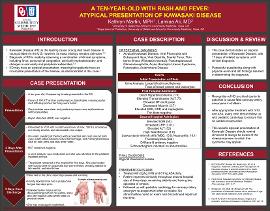| dc.description.abstract | INTRODUCTION: Kawasaki Disease is the leading cause of acquired heart disease in young children in the US. The exact cause of Kawasaki Disease remains unknown; however, a combination of clinical symptoms, including fever, conjunctival congestion, cervical lymphadenopathy, and changes in oral cavity and peripheral extremities, confirm the diagnosis.
CASE DESCRIPTION: A ten-year-old, ill-appearing Latina female presented to her primary pediatrician with a swollen face, left-sided subconjunctival hemorrhage, and mild erythematous rash on both arms and legs. Three days prior to presentation, she was seen at an ED due to emesis, abdominal pain, a painful pruritic erythematous rash on her hands, and an erythematous, blanching, maculopapular rash diffusely across her body. At that time, her conjunctivas were clear and her posterior pharynx was erythematous without exudates. A Rapid Strep A Screen administered at the ED was negative. While at the pediatrician’s clinic, another Rapid Strep test was conducted and remained negative. A urine analysis indicated large bilirubin and ketones with trace blood, protein and leukocytes. The patient was admitted to the pediatric inpatient service.
The patient remained in the hospital for five days, and remained febrile for four days with a maximum temperature of 102°F. During admission, labs demonstrated an elevated ESR and CRP . She was treated with doxycycline for suspected tick-borne illness, pending additional lab results, and sent home.
The patient returned to the clinic three days post-discharge reporting nausea and vomiting. The family reported her having a purple/blue tongue two days prior. On physical exam, she had a strawberry-like tongue and a desquamating rash on her palms, soles and peri-inguinal area. She was once again readmitted where her labs showed transaminitis, elevated CRP and ESR, and thrombocytosis. An echocardiogram indicated no abnormalities. Based on prior medical history, a presumptive diagnosis of Kawasaki Disease was made. The patient was treated with IVIG and 81mg ASA daily which was successful.
DISCUSSION: This case demonstrates a rare presentation of Kawasaki Disease, with 11 days of symptoms until clinic diagnosis. This diagnosis requires purposeful questioning, along with clinical, and lab findings. Recognition of this syndrome is critical due to its potential to cause fatal coronary artery aneurysms. After appropriate treatment with IVIG and ASA, every child should follow up with pediatric cardiology to ensure that no cardiac issues arise due to this disease. This atypical presentation of Kawasaki Disease should remind clinicians to always be aware of the diverse manners in which this syndrome may appear. | en_US |

